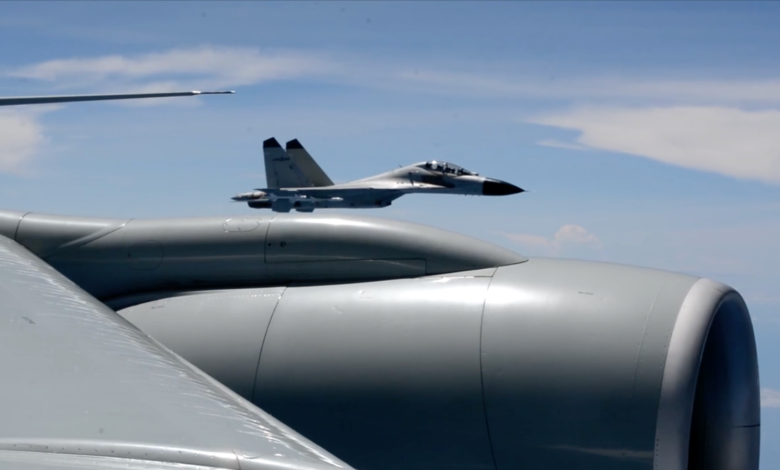Sky Wars: US pilots dodging “thuggery,” “risky” maneuvers from Russia, China

Above the clouds, U.S. military pilots are on the forefront of escalating tensions between the U.S., China, and Russia. The Pentagon released over 200 videos this week of encounters from the last few years in which U.S. pilots have had to dodge flares, maneuver away from potential collisions, and face down intimidation by Chinese and Russian pilots over contested areas like the Taiwan Straights and Syria.
Retired Air Force Maj. Gen. Larry “Stutz” Stutzriem told Task & Purpose that the encounters with Russian pilots is particularly concerning. As a fighter pilots in the 1980s, Stutzriem had similar run-ins with then-Soviet pilots.
“I don’t know what the military aviator equivalent of thuggery is but they’re not very competent pilots,” Stutzriem said. “The risk with the Russians is they do stupid things that could become escalatory and no one wants that to happen.”
Stutzriem told Task & Purpose about an incident in 1984 he had as a young fighter pilot over the Pacific Ocean.
Flying an F-4E Phantom from the Philippines, he was on a mission to surveil Soviet naval activity. American guidance was for pilots to be as predictable as possible as they flew. U.S. jets carried no weapons on the flights to “make us less provocative,” Stutzriem said.
As he and the F-4’s weapons officer prepared for the mission, he said, “I was told jokingly as we walked out the door: ‘Stutz don’t start World War Three.’”
As Stutzriem approached the Soviet ships, fully armed Soviet Yak-38 Forgers — a vertical take-off jet equivalent to the U.S. Harrier — scrambled from a Soviet aircraft carrier and came “screaming up at me,” he said.
The Russian jets came so quickly, Stutzriem said, that one pilot “had a closure rate that was just too hard for him to handle” and nearly collided with Stutzriem’s jet.
The Russian screamed past Stutzriem’s F-4 then “sliced down toward the ocean” as the pilot tried to regain control.
Stutzriem says he recognizes the same reckless approach to intercepts in the recent encounters. “We’re back to very, very aggressive tactics that really send a message,” he said. “‘We don’t want you here. We want to force the friction such that, you want to be the one that steps backward.’”
The Department of Defense has called out perilous Russian pilot behavior over countries in the Middle East. In March, the Air Force released images of a Russian SU-35 fighter aircraft harassing three U.S. MQ-9 drones on a mission against ISIS targets.
But the issue isn’t just limited to one U.S. adversary.
Subscribe to Task & Purpose Today. Get the latest military news and culture in your inbox daily.
The 2023 version of the colloquially dubbed “China Military Power Report” released Thursday by the Pentagon said the U.S. had cataloged 180 examples of “risky and coercive” flying by Chinese pilots as part of China’s “centralized and concerted campaign” to discourage the U.S. and NATO from flying over and sailing into waters they claim territorial sovereignty over but which are not recognized by most of the international community.
Chinese pilots have executed barrel-rolls and other acrobatics in close proximity to U.S. planes, flashed weapons from their fighter aircraft and fired chaff in front of U.S. pilots. Chaff is bright-burning flares and reflective material designed to misdirect incoming missiles but that pose dangers to aircraft flying close nearby.
“When you get too unsafe and unprofessional, that’s really concerning behavior, right? People’s lives are at risk,” Adm. John Aquilino, Commander of the Indo-Pacific Command said about the pilot interactions earlier this week.
Since 2021, the U.S. has seen a “set of actions that have brought airplanes much closer together than are comfortable for those in the cockpit,” Aquilino said. Flying 15 feet off an aircraft’s wing for 45 minutes, for example, “has too much of a chance to lead to an accident.”
In December 2022, a Chinese J-11 fighter jet came within 20 feet of the nose of a U.S. military aircraft operating in international airspace over the South China Sea. In May, the DOD released a cockpit video of a Chinese J-16 “thumping” a U.S. RC-135 aircraft by forcing it to fly directly behind in its wake turbulence.
Prior to fall 2021, China’s military “routinely” intercepted foreign air and maritime assets operating in the Indo-Pacific. However those interactions spiked between fall 2021 and fall 2023, with over 180 instances of “coercive and risky air intercepts against its aircraft” and nearly 100 instances in the air and sea against U.S. Allies and partners in the region like Australia and the Philippines.
According to the new report, the U.S. intelligence community does not believe the aggressive flying is just the acts of over-aggresive pilots. China has claimed it is “justified to take forceful countermeasures” against U.S. activities they’ve deemed “provocative.” This “suggests centralized coordination, not the behavior of a few isolated PLA officers, according to the report.
“It doesn’t necessarily mean that Xi Jinping or the Central Military Commission is literally reviewing every one of these actions. But the fact that there is no one being punished says that the higher level is okay with this,” said Dean Cheng, senior advisor to the China program at the U.S. Institute of Peace.
Cheng said that the repercussions for an accident between U.S. and Chinese military pilots is different between the two countries.
“The Chinese don’t seem to be nearly as worried in general about inadvertent escalation and accidental war whereas this is a major staple of Western strategic thought,” he said. China is more willing to say “You know what? You don’t want bad things to happen. Go away,” he added.
There have been more interactions in the past two years than in the previous decade, the report states.
With Russia, the most notable recent interaction happened with an uncrewed aircraft. Russian pilots dropped parachute flares in front of U.S. drones, forcing the aircraft to use evasive maneuvers. One Russian pilot also engaged their aircraft’s afterburner in front one of the MQ-9s and reduced the U.S. operator’s ability to safely fly the drone, according to the Pentagon.
In September, Lt Gen Alex Grynkewich, the lead Air Force commander of CENTCOM told reporters that the pace of Russian activity “has remained relatively constant, maybe even decreased.”
“In the past, I would have told you that I was very concerned about Russian air to ground aircraft armed with air ground weapons flying directly over our forces. That’s very rare and in fact, hasn’t happened for several weeks,” he said, adding that their actions are still “unprofessional” because it violates agreed-upon “rules of the road,” he said.
Bruce Jones, a senior fellow at the Brookings Institute with policy experience in international security said the concerning interactions are not only taking place in the air, but also at sea – with the South China Sea and for Russia, the Baltic Sea.
Both Russia and China are using these near misses or close approaches between aircrafts to operationalize a concept known as the “zone of primary influence,” he said, meaning: “The message is, this is our territory.”
In both cases, but “much more substantially” with China, the countries are “trying to make it more risky and more costly” for the United States and NATO to traverse internationally recognized air and maritime areas that they claim ownership of.
Jones said they’re trying to push the U.S. “as far as they can” and hopefully get U.S. entities to back down by flying or sailing through those waters less. However Jones doesn’t believe they’re trying to provoke a full scale war through their actions, “at least not yet.”
Russian pilots behavior is “much more risk taking and provocative even than the Chinese,” he said “I don’t think that China believes that it’s at war with NATO or the West. It’s trying to assert its dominance.”
The latest on Task & Purpose





